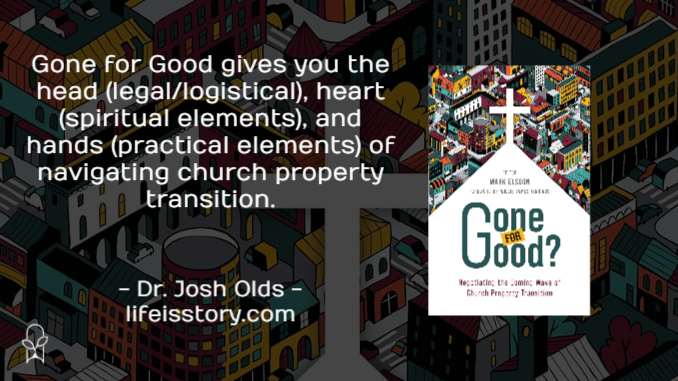
Published by Eerdmans on January 9, 2024
Genres: Academic, Non-Fiction
Buy on Amazon
Goodreads

Is your church facing the difficult decision to sell property? Consider using church buildings and land to further the gospel mission. Mark Elsdon, author of We Aren’t Uncovering Hidden Resources for Mission and Ministry , revisits questions of church resources with a team of pastors, scholars, developers, urban planners, and more. This collection of essays sheds light on how church communities can transform their properties to serve their neighborhoods. Essays explore spiritual, sociological, and practical aspects of church property transition, • assessing the impacts of churches on their neighborhoods—and the gaps they will leave behind • developing church property into affordable housing • transforming ministry in rural churches • partnering with Indigenous peoples to return land • fostering cooperation between congregations, developers, and city planners • navigating zoning laws • working with foundations and funders Thousands of church properties worth billions of dollars are being sold or repurposed each year. Nothing can stop the currents of change. But congregations and cities can take steps now to ensure a legacy directed toward communal good rather than private interests. Gone for Good? will be an invaluable guide in navigating these radical shifts in church life and ministry. Jennie Birkholz, David Bowers, Philip Burns, Mark D. Constantine, Joseph Daniels Jr., Patrick Duggan, Mark Elsdon, Ashley Goff, Jim Bear Jacobs, A. Robert Jaeger, Willie James Jennings, Tyler Krupp-Qureshi, Eileen Lindner, Elizabeth Lynn, Nadia Mian, Kurt Paulsen, Jill Shook, Coté Soerens, Rochelle A. Stackhouse, Keith Starkenburg, Andre Johnny White
In 2020, I was living in Philadelphia for a few months just down the road from St. Edwards church, an abandoned cathedral that, in 1995 housed the homeless and is where Shane Claiborne and his Simple Way organization began. In 2020, St. Ed’s was still abandoned but the city had locked up the building. The Simply Way held a protest there, then we entered the building with the intentions of setting up to use as a homeless shelter. The city shut it down later that day.
Abandoned church properties like St. Ed’s are more common than you might think. As churches decline and buildings age, there are an increasing number of church properties with no clear future. What are we to do? In Gone for Good? (a clever title holding multiple meanings), Mark Elsdon gathers together a group of experienced and knowledgeable Christian leaders to offer their perspectives on the coming (and now here) wave of church property transition.
This is a fascinating book, even though its appeal is probably limited to church leaders. I would consider a must-read for church planters, trustees, or pastors/leaders dealing with an impending church move or closure. The chapters range from the philosophical to the practical. They acknowledge that many property transitions are unwanted and come as a result of church stagnation and decline, yet they retain a hopefulness and optimism for the future.
Part one of Gone for Good covers some of the practical elements of church closures, offering communities a reminder of the services the church provided, the influence it had on the community, and how to pivot to retain those positive influences and repurpose the building for community use. It discusses the good that church buildings provide and even suggests that some building closures could result in churches relocating to more useful places within their community.
Part two handles the spiritual element of church property transition. Jim Bear Jacobs writes a powerful essay on how churches transitioning away from their property can use it as an opportunity to return stolen land. Ashley Goff speaks prophetically about how God’s call is bigger than a building and that the work of ministry was always meant to be outside church walls. Jennie Birkholz writes about the value of rural churches. Gone for Good doesn’t just demand we put a happy face on these losses, but rather encourages us to see where we can reclaim beauty from ashes. I also appreciate the theme that we can’t just go back to “normal,” but should rather pivot to something new that can lead to better flourishing.
Part three gets into the technical details. Nadia Mian writes about working with zoning commissions to build bonds between the church and civil government. There’s a chapter on how to build a real estate advisory team. Kurt Paulsen writes about proactive city planning for church property transitions.
Altogether, in Gone for Good, you get the head (legal/logistic elements), heart (spiritual elements), and hands (practical ministry elements) of navigating church property transition. Whether you’re a church plant considering buying a building or an aging church facing closure, there is practical and spiritual wisdom for you here.
